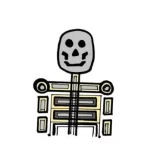
This post contains almost all the topics of 3rd BHMS Systemic surgery along with their most important and frequently asked questions from different Indian university examinations.
This post is prepared for the benefit of the Surgery students who are going to appear in university examinations.
Number of papers – 02
Marks: Paper 1-100 marks; Paper 2-100 marks.
Paper-1
- Section A: General Surgery – 50 marks
- Section B: Homoeopathic Therapeutics related to General Surgery – 50 marks
Paper- 2
- Section A: Systemic Surgery (Including ENT, Ophthalmology, Dentistry)- 50 marks
- Section B: Homoeopathic Therapeutics (Including ENT, Ophthalmology, Dentistry) – 50 marks
The Paper 1 and Paper 2 divisions are prepared on the basis of syllabus of B.H.M.S. (Degree course) applicable from the academic session 2015-2016, as per guidelines of Central council of homoeopathy.
All the questions are given under their related chapters.
- FQ: Full Question
- SFQ: Semi Full Question
- SN: Short Note
This post contains only the topics of Paper 2 (SYSTEMIC SURGERY AND HOMOEOPATHIC THERAPEUTICS). Topics of Paper 1 are given in a separate post, 3rd BHMS GENERAL SURGERY FREQUENTLY ASKED QUESTIONS.
Examination shall be conducted in Third B.H.M.S (not in Second B.H.M.S).
Table of Contents
ToggleSECTION A (SYSTEMIC SURGERY)
CHEST
- FQ: Empyema thoracis- Definition, aetiology, classification, diagnosis and treatment.
- FQ: Lung abscess- Definition, aetiology, classification, diagnosis and treatment and complications.
- SFQ/SN: Haemothorax
- SFQ: CA Lung
- SFQ: Complications of thoracic surgery.
- SFQ: Tracheostomy-indications and contraindications
- SN: Pneumothorax
- SN: Solitary nodule
- SN: Surgical emphysema
- SN: Tube thoracostomy (chest tube)
CARDIO VASCULAR SYSTEM
- FQ/SFQ: Varicose veins- Etiopathology, clinical features and management of lower limb varicose veins.
- FQ: Chronic arterial occlusion- Etiology, signs and symptoms, investigations and local examination.
- SFQ: Aneurysm
- SN: Arterio venous fistula (AV Fistula)
- SN: Non-Healing ulcers of leg.
- SN: Raynaud’s disease
GASTRO-INTESTINAL TRACT
GASTRO-INTESTINAL TRACT
- FQ/SFQ: Haemorrhoids (piles)
- FQ: Lower GI bleeding- Clinical evaluation, diagnosis, treatment and management.
- FQ: Write down causes of upper GI bleeding, its differential diagnosis and management.
- SN: Anal fissure (fissure-in-ano)
- SN: Ano-rectal abscess
- SN: Degrees of haemorrhoids
- SN: Perianal fistulas (fistula-in-ano)
- SN: Resuscitation of GIT
- SN: Upper GI endoscopy
ACUTE ABDOMEN
- FQ/SFQ: Acute intestinal obstruction
- FQ/SFQ: Acute Peritonitis
- FQ: Acute abdomen- Clinical features, differential diagnosis, management and treatment.
- SFQ: Rupture of spleen
- SFQ: Splenomegaly/Hypersplenism
- SN: Differential diagnosis of pain in Right iliac fossa.
- SN: Sigmoid volvulus
- SN: Splenectomy- Causes and indications
HEPATO BILIARY DISEASE
- FQ: Amoebic liver abscess
- FQ: Hydatid cyst of liver
- SN: Liver abscess
DISEASES OF GALL-BLADDER AND BILIARY TREE
- FQ/SFQ: Acute cholecystitis
- FQ/SFQ: Gall stone disease/ Cholelithiasis
- FQ: Acute pancreatitis
- FQ: Obstructive jaundice
ABDOMINAL WALL HERNIAS
- FQ: Hernia- Types, risk factors, clinical features, complications and treatment.
- SN: Differential diagnosis of Inguino scrotal swelling.
- SN: Femoral hernia
- SN: Incisional hernia
- SN: Inguinal hernia
- SN: Strangulated hernia
- SN: Umbilical hernia/Paraumbilical hernia
STOMACH AND DUODENUM
- FQ/SFQ: Peptic ulcer disease
- SFQ: Classification and characteristics of ulcer
- SN: Achalasia of oesophagus/ Cardiospasm
- SN: Difference between Gastric ulcer and Duodenal ulcer
- SN: Duodenal ulcer
- SN: Dysphagia
- SN: Gastric cancer
- SN: Gastric outlet obstruction
- SN: Gastric ulcer
- SN: Oesophagitis
UROLOGY
- FQ: Renal calculi/ Renal stone/ Nephrolithiasis-Types, clinical features, diagnosis and treatment.
- FQ: Renal tumour
- FQ: Urinary tract infection (UTI)
- SFQ/SN: Benign prostatic hyperplasia (BPH)
- SFQ: Scrotal swelling
- SN: Acute renal failure
- SN: Chronic pyelonephritis
- SN: Differential diagnosis of haematuria
- SN: Hydrocele
- SN: Perinephric abscess
- SN: Urethral stricture
SKIN
- SFQ: Define benign tumour with adenoma, papilloma and fibroma in detail.
- SFQ: Dermoid cyst
- SFQ: Papilloma
- SN: Adenoma
- SN: Basal cell carcinoma
- SN: Boil/Furuncle
- SN: Carbuncle
- SN: Cellulitis
- SN: Cyst
- SN: Examination of tumour and cyst
- SN: Impetigo
- SN: Sebaceous cyst
- SN: Skin grafting
- SN: Squamous cell carcinoma
THYROID GLAND
- FQ/SFQ: Thyroglossal cyst
- FQ: Thyroid enlargement/ Goitre
- FQ: Toxic goitre/ Thyrotoxicosis
- SFQ: Cold abscess of neck
- SFQ: Differential diagnosis of lateral swelling of neck
- SFQ: Investigations of thyroid disorders/ Thyroid function tests
- SN: Toxic nodular goitre
BREAST
- FQ: Ca Breast
- SFQ/SN: Fibroadenoma
- SFQ: Differential diagnosis of lump in breast
- SFQ: Investigations for breast complains.
- SN: Acute mastitis
- SN: Breast abscess
ORTHOPEDIC SURGERY
- FQ/SFQ: Acute osteomyelitis
- FQ: Fractures- Classification, diagnosis, management and complications.
- SFQ: Frozen shoulder
- SFQ: Lumbar disc prolapse
- SFQ: Non-union of fracture with its management
- SFQ: Osteoarthritis
- SFQ: Osteoporosis
- SFQ: Paratendinitis with tendinitis
- SFQ: Tennis elbow
- SN: Amputations
- SN: Bursitis
- SN: Colle’s fracture
- SN: Complement syndrome
- SN: Compound fracture
- SN: Delayed union of fracture
- SN: Dislocations
- SN: Ganglion
- SN: Gout
- SN: Lateral epicondylitis
- SN: Methods of immobilization in cases of fractures.
- SN: Pott’s disease
- SN: Rheumatoid arthritis
- SN: Septic arthritis
- SN: Suppurative tenosynovitis
- SN: Tendinitis
- SN: Tendon rupture
- SN: Tuberculous arthritis
EAR, NOSE AND THROAT
- FQ: ASOM (Acute Suppurative Otitis Media)
- FQ: CSOM (Chronic Suppurative Otitis Media)
- FQ: Lymphoedema (Enlargement of lymphnodes)- Types, with primary lymphadenitis in detail/ With Hodgkin’s disease.
- FQ: Tonsillitis
- SFQ/SN: Allergic rhinitis
- SFQ: Chronic tonsillitis
- SFQ: Deafness- Causes and diagnosis
- SFQ: Nasal polyp
- SFQ: Sinusitis
- SFQ: Tonsillectomy
- SFQ: Types of lymphedema
- SN: Acute lymphadenitis
- SN: Mixed parotid tumour
- SN: Otorrhoea
- SN: Parotitis
- SN: Ranula
- SN: Sinus and Fistula
- SN: Tubercular lymphadenitis
OPHTHALMOLOGY
- FQ/SFQ: Red eye
- FQ: Cataract
- FQ: Glaucoma- Classification, details on open glaucoma, signs and symptoms and management
- SFQ/SN: Conjunctivitis
- SFQ: Glaucoma classification
- SFQ: Stye
- SN: Conjunctivitis
- SN: Corneal ulcer
- SN: Diagnosis Retinopathy
- SN: Myopia
- SN: Trachoma
DENTAL SURGERY
- SFQ: Cleft lip
- SFQ: Differential diagnosis of ulcer in tongue with signs and symptoms of CA tongue.
- SN: Cleft palate
- SN: Dental caries
- SN: Dental cyst
- SN: Dental fistula
- SN: Dentigerous cyst
- SN: Epulis
- SN: Odontome
SECTION B (HOMOEOPATHIC THERAPEUTICS)
The word Therapeutic means treatment of the disease by application of medicinal substance.
Homoeopathic therapeutics means application of remedial agents on the basis of symptoms similarity.
- The answer of homoeopathic management (therapeutics) includes the homoeopathic medicines with their indications related to that particular disease condition.
- In this post model questions are given with a list of their most important MEDICINES written in CAPITAL LETTERS.
- For exam if you are attending FULL QUESTION, generally 3 to 5 remedies shall be asked to write (may be asked as any 5 or name of the remedies already given to write).
- Same applies on Semi Full Questions and Short Notes.
- While attending the Full questions and Semi full questions read carefully that what is being asked to write in detail along with the homoeopathic therapeutics.
FULL QUESTIONS
- Types and management of Tonsillitis. Write down the scope of homoeopathy in tonsillitis.
- Indications of: BARYTA CARB, CALCAREA CARB, LAC CAN, LACHESIS.
- Different conditions of Acute abdomen with indications any 5 homoeopathic medicines.
- Complications and management of Acute Appendicitis.
- Indications of: ARSENIC ALB, GRATIOLA, IRIS TENAX, BELLADONNA, LACHESIS.
- Scope and Limitations of homoeopathy in Cataract.
- Indications of: SILICEA, PHOSPHORUS, CALC FLOUR, CAUSTICUM.
- Indications of any 5 homoeopathic remedies for Acute renal calculi.
- HYDRANGEA, UVA URSI, LITHIUM CARB, OCIMUM CAN, LYCOPODIUM, SARSAPARILLA
- Fracture– Types. Of Rheumatism
- Indications of: RHUS TOX, ACTEA SPICATA, LEDUM PAL.
- Causes of lateral swelling of neck.
- Indications of: BARYTA CARB, LACHESIS, LAC CANINUM
- Clinical features of Nasal Polyp.
- Indications of: CALCAREA CARB, TEUCRIUM MARUM, LEMNA MINOR, SANGUINARIA
- Causes of vertigo.
- Indications of: CONIUM, COCCULUS INDICUS, THERIDION
10.Clinical features and causes
- Indications of: LAPIS ALBUS, LYCOPUS VIRGINICUS, FUCUS VESICULOSUS
- Causes of Red eye.
- Indications of: EUPHRESIA, PULSATILLA, APIS MEL
- Clinical features of Carcinoma of Breast.
- Indications of: CONIUM, BRYONIA, ASTERIS RUBENS, PHYTOLACCA
- Aetiology of Thrombo angiitis obliterans.
- Indications of: SECALE COR, LACHESIS, CARBO VEG.
- Clinical features of chronic duodenal ulcer.
- Indications of: ROBINIA, LYCOPODIUM, ANACARDIUM, NUX VOMICA, CARBO VEG, NATRUM PHOS, CALC SULPH
- Causes and clinical features of Haemorrhoids (Piles).
- Indications of: AESCULUS HIPPO, NITRIC ACID, NUX VOMICA, SULPHUR, FERRUM PHOS, CALC FLUOR, MAG PHOS, SILICEA
SEMI FULL QUESTIONS
- Acute management of Conjunctivitis
- Indications of PULS, ALLIUM CEPA, EUPHRASIA, APIS MEL, ACONITE
- Homoeopathic management of Intestinal obstruction with PLUMBUM MET and OPIUM.
- Define Meniere’s disease and write down the indications of COCCULUS and CHININUM SULPH.
- Clinical features of BPH (Benign Prostatic Hypertrophy)
- Indications of: SABAL SERROLATA, CONIUM, PAREIRA BRAVA, SARSAPARILLA
- Differential diagnosis of bleeding per rectum with Indications of NITRIC ACID, PAEONIA, RATAHNIA
- Causes of Splenomegaly with Indications of CEANOTHUS and CHELIDONIUM.
- Homoeopathic approach to treat the Varicose veins.
- Carbuncle with indications of TARENTULA CUBENSIS, ANTHRACINUM, SILICEA
- Chronic suppurative otitis media (CSOM) with homoeopathic management.
- Acute sinusitis with indications of KALI BICH, HYDRASTIS, STICTA PUL.
- Causes of Red eye with any 5 homoeopathic remedies to manage the case.
- Diagnostic signs of Gall Stones with any 5 homoeopathic medicines.
- CHELIDONIUM, BERBERIS VUL, NUX VOM, CALC CARB, NAT SULPH, MAG PHOS.
- Causes of Epistaxis with indications of IPECAC, CROTALUS HORRIDUS, TEUCRIUM MARUM.
- Clinical features and complications of Acute Cholecystitis with indications of CHELIDONIUM, BERBERIS, NUX VOMICA, LYCOPODIUM, CALC CARB.
- Define Tenosynovitis with indications of RUTA, RHUS TOX, CALENDULLA in tendon rupture.
- Gout with any 3 homoeopathic medicines.
- Homoeopathic management of Osteoarthritis.
- How will you differentiate between Sprain and Dislocation? Write down any 3 homoeopathic remedies?
- Indications of: HAMAMELIS, ARNICA, IPECAC, FERRUM PHOS
SHORT NOTES
- Carbuncle- ANTHRACINUM, LACHESIS, TARENTULA CUBENS, NIT ACID.
- Stye- PUILS, STAPHY, GRAPHITES
- Varicose vein- CARBO VEG, VIPERA
- Syphilitic ulcers- KALI BICH, NITRIC ACID, MERCURIUS, ARSENIC ALB, CALC FLOUR.
- Dental carries- KREOSOTUM, STAPPHYSAGRIA, HECLA LAVA, MEZERIUM, THUJA.
- Sinusitis- KALI BICH, ALLIUM CEPA.
- Nasal polyp- LEMNA MINOR.
- Causes of Acute prostatic trouble with write down which medicine is known as homoeopathic Catheter?
- Renal stone- OCIMUM CAN, HYDRANGEA, BERBERIS VULGARIS, SARSAPARILLA.
- Gall stone- CARDUS MARINUS, LYCOPODIUM.
- Lymphadenitis- PHYTOLACCA, CALC CARB, BARYTA CARB.
- Fistula-in Ano-CALC SULPH, CAUSTICUM
- Glaucoma- CEDRON, GELSEMIUM
- Sebaceous cyst- KALI BROM
- Cataract- PHOS, SILICEA
- Ophthalmia Neonatorum- ARGENTUM NITRICUM
- Quinsy- MERC SOL
- BPH- SABAL SERRULATA, CHIMAPHILA UMBELLATA, SRSAPARILLA, CONIUM
- Ascites- APOCYNUM
- Pyorrhoea- KREOSOTE
- Peptic ulcer- PHOS, KALI BICH, ANACARDIUM
- Acute abdomen- BRYONIA
- Mastitis- BELLADONNA, LAC CAN.
- Haematuria- LYCO, CANTHARIS, HAMAMRLIS, BERBERIS VULGARIS
- Cellulitis- APIS MEL
- Toothache- CHAMOMILLA, KREOSOTUM
- Third degree of piles- ALOE, AESCULUS
- Goitre- BROMIUM, IODUM
- Aneurysm- BARYTA MUR
- Splenitis- CHININUM SULPH
- Hodgkin’s disease- IODUM
- Parotitis- BELLADONNA
- Hydrocephalus- HELLEBORUS
- Epistaxis- PHOSPHORUS, KALI PHOS
- Boil- ARNICA
- Lipoma- THUJA
- Iritis- EUPHRASIA
- Fistula-in- Ano- RATANHIA, IGNATIA, NITRIC ACID, SILICEA
- Swelling of neck- BARYTA CARB, LAC CAN.
- Intestinal Obstruction- PLUMBUM MET
- Pleural effusion- BRYONIA
- Red eye- BELLADONNA
- Any two homoeopathic remedies for non-heeling ulcers.
- Meniere’s disease- Any two homoeopathic medicines
- Conjunctivitis- PULS, APIS MEL
- Homoeopathic management for glandular hypertrophy.
- Allergic rhinitis- any two homoeopathic medicines.
- Dysphagia- COLCHICUM, MERCURIUS, SILICEA, CONIUM.
- Carcinoma of the stomach- CONIUM, CONDURANGO, HYDRASTIS
- Any two homoeopathic remedies for Urinary tract infection.
- Fracture- CALCAREA PHOS
- Gout- COLCHICUM
- Non-union of fracture- SYMPHYTUIM, CALENDULLA, CALC PHOS
- Rheumatism- CAUSTYICUM
- Tenosynovitis- RUS TOX, RUTA
Hope you find this post helpful for the thorough preparation of examination.
Questions for SURGERY PAPER 1 are written in an another separate post, you just need to click on the hyperlinked text here, 3rd BHMS GENERAL SURGERY FREQUENTLY ASKED QUESTIONS.
You can also find useful content of other subjects of Third B.H.M.S. following the below mentioned links,













I enjoyed reading this post. It’s concise yet packed with useful information. Thanks!